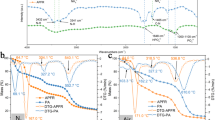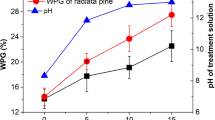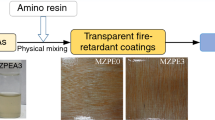Abstract
Scots pine (Pinus sylvestris) wood was treated with disodium octaborate terahydrate (DOT) and guanyl urea phosphate (GUP) to impart flame retardance. The flame retardance and thermal stability of pine wood was evaluated by limited oxygen index (LOI), UL-94, thermogravimetry and cone calorimeter. The results indicated that the thermal stability was significantly improved with impregnation of a 1:1 DOT/GUP 10–15% aqueous solution. DOT/GUP treated pine wood fell within the nonflammable range of the Chinese national standard of nonflammable materials with LOI value of 40.8% using 10% (w/w) aqueous solution. Thermogravimetric analysis showed that the treated pine wood samples reduced the weight loss, increased residual char, but lowered pyrolysis temperature. The highest char yield was obtained from pine wood treatments with DOT/GUP. The flammability parameters by the cone calorimeter, including heat release rate (HRR), total heat release (THR), smoke production rate (SPR), and total smoke production (TSP) showed that most parameters (HRR, THR, SPR, TSP) of the treated pine wood samples decreased especially for the DOT/GUP treatment, which indicated a synergistic flame retardant and smoke suppression effect. This finding has not been reported in previous literature. The flame retardant was found to have penetrated into the cell wall with scanning electronic microscopic observation, which makes DOT/GUP enhance char-forming ability of wood.








Similar content being viewed by others
References
ASTM (2008) D 2836: Standard test method for measuring the minimum oxygen concentration to support candle-like combustion of plastics (oxygen index). American Society for Testing and Materials, West Conshohocken
Baysal E, Altinok M, Colak M, Ozaki SK, Toker H (2007) Fire resistance of douglas fir (Pseudotsuga menzieesi) treated with borates and natural extractives. Bioresour Technol 98(5):1101–1105
Codina R, Lockey RF, Diwadkar R, Mobly LL, Godfrey S (2003) Disodium octaborate tetrahydrate (.) application and vacuum cleaning, a combined strategy to control house dust mites. Allergy 58:318–324
Gao M, Yang SS, Yang RJ (2006) Flame retardant synergism of GUP and boric acid by cone calorimetry. J Appl Polym Sci 102:5522–5527
Hagen M, Hereid Delichatsios MA, Zhang J, Bakirtzis D (2009) Flammability assessment of fire-retarded Nordic Spruce wood using thermogravimetric analyses and cone calorimetry. Fire Saf J 44:1053–1066
Hisham A, Essawy AA, Moustafa B, Nadia HE (2010) Enhancing the properties of urea formaldehyde wood adhesive system using different generations of core-shell modifiers based on hydroxyl-terminated dendritic poly(amidoamine)s. J Appl Polym Sci 115(1):370–375
Jiang J, Li J, Hu J, Fan D (2010) Effect of nitrogen phosphorus flame retardants on thermal degradation of wood. Construct Build Mater 24:2633–2637
Jiang T, Feng XH, Wang QW, Xiao ZF, Wang FQ, Xie YJ (2014) Fire performance of oak wood modified with N-methylol resin and methylolated guanylurea phosphate/boric acid-based fire retardant. Construct Build Mater 72:1–6
Jiang JX, Li JZ, Gao Q (2015) Effect of flame retardant treatment on dimensional stability and thermal degradation of wood. Construct Build Mater 75:74–81
Liodakis S, TsaparaV, Agiovlasitis IP, Vorisis D (2013) Thermal analysis of Pinus sylvestris L. wood samples treated with anew gel-mineral mixture of short- and long-term fire retardants. Thermochim Acta 568:156–160
Obanda ND, Shupe FT, Barnes MH (2008) Reducing leaching of boron based wood preservatives-a review of research. Bioresour Technol 99:7312–7322
Pratt’ JE, Quill K (1996) A trial of disodium octaborate tetrahydrate for the control of Heterobasidion annosum. Eur J For Path 26:297–305
Qu HQ, Wu WH, Jiao YH, Xie JX, Xu JZ (2011) Investigation on the thermal decomposition and flame retardancy of wood treated with a series of molybdates by TG-MS. J Therm Anal Calorim 105:269–277
Simkovic I, Martvonova H, Manıkova D, Grexa O (2005) Flame retardance of insolubilized silica inside of wood material. J Appl Polym Sci 97:1948–1952
Simkovic I, Martvonova H, Manikova D, Grexa O (2007) Flammability studies of sodium thiosulphate or metabisulphite impregnated wood using cone calorimeter. Fire Mater 31:137–145
Tang Y, Wang DY, Jing XK, Ge XG, Yang B, Wang YZ (2008) A formaldehyde- free flame retardant wood particleboard system based on two-component polyurethane adhesive. J Appl Polym Sci 108:1216–1222
Temiz A, Gezer ED, Yildiz UC, Yildiz S (2008) Combustion properties of alder (Alnus glutinosa L.) Gaertn. Subsp Barbata (CA Mey) Yalt. and southern pine (Pinus sylvestris L.) wood treated with boron compounds. Construct Build Mater 22(11):2165–2169
Tomak ED, Cavdar AD (2013) Limited oxygen index levels of impregnated Scots pine wood. Thermochim Acta 573:181–185
Tomak ED, Baysal E, Peker H (2012) The effect of some wood preservatives on the thermal degradation of Scots pine. Thermochim Acta 547:76–82
Wang Q, Li J, Zhang SR, Qian XR (1999) Synthesizing method for wood flame retardant. Patent CN97118353.8
Wang Q, Li J, Winandy EJ (2004) Chemical mechanism of fire retardance of boric acid on wood. Wood Sci Technol 38(5):375–389
Wang SY, Yang TH, Lin LT, Lin CJ, Tsai MJ (2008) Fire-retardant-treated low-formaldehyde-emission particleboard made from recycled wood-waste. Bioresour Technol 99:2072–2077
Acknowledgements
This work was financially supported by the Fundamental Research Funds for the Central Universities (DL13DB01) and Program for New Century Excellent Talents in University (NCET-13-0710).
Author information
Authors and Affiliations
Corresponding author
Rights and permissions
About this article
Cite this article
Guo, C., Wang, S. & Wang, Q. Synergistic effect of treatment with disodium octaborate tetrahydrateand guanyl urea phosphate on flammability of pine wood. Eur. J. Wood Prod. 76, 213–220 (2018). https://doi.org/10.1007/s00107-017-1171-1
Received:
Published:
Issue Date:
DOI: https://doi.org/10.1007/s00107-017-1171-1




